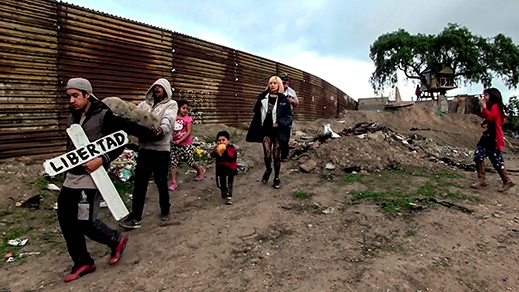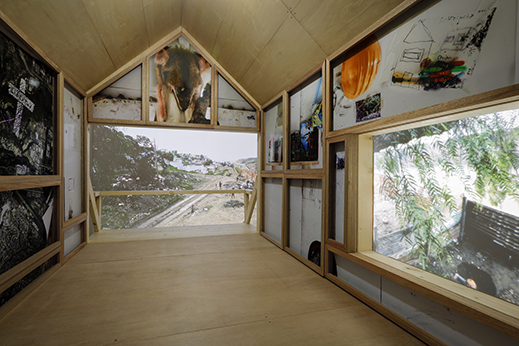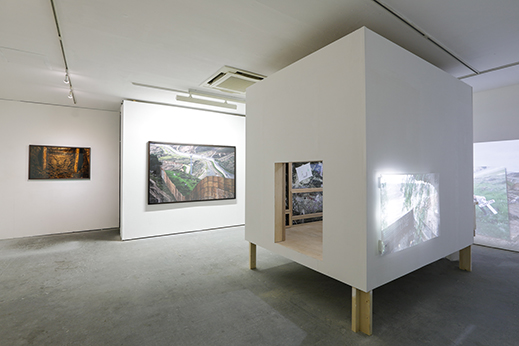 |
|
Here and There introduces art, artists, galleries and museums around Japan that non-Japanese readers and first-time visitors may find of particular interest. The writer claims no art expertise, just a subjective viewpoint acquired over many years' residence in Japan.
|
|
 |
|
|
 |
 |
Deconstructing Borders: A Timely Installation by Chim Pom
Alan Gleason |
 |
|
Chim Pom, U.S.A. Visitor Center, 2016. |
Amid the current global epidemic of anti-immigrant hysteria, the process of crossing international boundaries has never seemed so fraught. Though much is said about art as a medium that transcends such artificial constructs, few artists incorporate actual land borders into their work. Understandably so, since the attempt might entail less than cordial treatment at the hands of immigration bureaucracies, border patrols, and worse.
Trust Chim Pom to step into the breach and go where others fear to tread. The six Tokyo-based provocateurs have flouted boundaries before, notably with their incursions into the exclusion zone around Fukushima Nuclear Power Plant No. 1, the first of which took place mere weeks after the reactors exploded in March 2011. Fukushima has been the fodder for several of the collective's exhibitions, the most recent being Don't Follow the Wind in 2015. Now the group has seized the zeitgeist again with its inimitable gusto and razor-sharp timing in The other side, a multimedia meditation on the U.S.-Mexico border and its (pre-Trump) wall. Prescient as always, Chim Pom filmed its guerrilla-art activities along the fence on the Mexican side, in Tijuana, in the summer of 2016, several months before the American presidential election.
 |
|
Installation in the no-man's land between border fences. Chim Pom, LIBERTAD, 2017. |
The impetus for this project was not the groundswell of "Build the wall!" nativism that helped elect the new president, however, but an incident that directly affected Ellie, Chim Pom's sole female member. Since 2012, Ellie has been on the U.S. Homeland Security Department's blacklist because she happened to be part of a TV shoot heading for Hawaii when it turned out that one of the crew, apparently in a misguided attempt at humor, had responded in the affirmative to a routine question about "terrorist associations." Tainted by association in turn, the entire crew was denied entry and remains persona non grata in the U.S. to this day.
Never ones to pass up an opportunity to milk an absurd situation for its satirical potential, Ellie and her Chim Pom comrades began making plans to interact with the U.S. by other means and in 2016 wound up in Tijuana, where they discovered Colonia Libertad, a poor neighborhood hard by the border. There they met a family who had built their house right up against the U.S.-built wall, which in this locale at least is a rusty, surprisingly flimsy-looking metal fence. A large tree in the family's yard afforded panoramic views of the no-man's land between this barrier and a second, more daunting one erected several yards farther into American territory. Snaking through the bleak terrain is a road plied by U.S. Border Patrol vehicles on the lookout for people climbing or burrowing to "the other side." Yet this strip of land is also a convenient garbage dump, and youngsters from Colonia Libertad make frequent forays there and back for fun and adventure.
 |
|
Preparing to take the "grave of liberty" over the wall. Chim Pom, LIBERTAD, 2017. |
Ellie et al. made themselves right at home, playing with the neighborhood kids, interviewing the family matriarch, building a tree house in the big tree, and digging a hole down to the buried base of the wall, into which Ellie lowered herself and literally "set foot" on American soil at last. Up top, the artists and their new friends hauled a plastic cross marked LIBERTAD -- a grave marker for liberty -- over the wall and briefly set it up on the U.S. side, scrambling back over to Mexico before the Border Patrol took notice.
On display until 9 April at the Mujin-to Production gallery in Tokyo's Koto ward, The other side provides a thorough overview of all these exploits. Though it initially appears to be a breezily slapdash affair in keeping with Chim Pom's devil-may-care aesthetic, the show actually utilizes the gallery's compact space in a well-organized and efficient manner. The centerpiece is a full-size reproduction of the Colonia Libertad tree house, pointedly named the "U.S.A. Visitor Center." A surprisingly roomy shack, it is walled with photos of the items that adorn the original structure, among them a five-dollar bill with Trump's face replacing Lincoln's, and a coyote pelt. The latter alludes not only to the smugglers who guide people across the border from Mexico, but also to a 2014 New York installation, COYOTE, that Ellie was unable to participate in due to her visa travails. (That show was an homage to Joseph Beuys, who spent several days in a room with a live coyote for his 1974 New York performance I Like America and America Likes Me.)
 |
|
Installation view of tree house interior. Chim Pom, "The other side," Mujin-to Production, Tokyo, 2017. Photo: Kenji Morita |
The tree house is a pleasant place to sit in, not least because its balcony opens onto a wall-sized video showing the view of the border from the house, as well as the performance of installing the LIBERTAD marker on the other side. Through another window one can watch a video of the digging of the hole that took Ellie down under. In a dark and deliberately claustrophobic closet-like space curtained off from the main room, another video takes the viewer into the hole, where Ellie's running commentary accompanies her own incursion into U.S. territory. Also on display is a plaster cast of the footprints she made there.
|
Ellie down the hole, and her footprints on U.S. soil under the wall. Chim Pom, The Grounds, 2017. Photo: Yuki Maeda |
The most absorbing element of the installation is a longer video in another chamber, furnished with seats and headphones, where visitors can spend time with Chim Pom and their adopted family in Colonia Libertad. Ellie is the undisputed star of the footage, as she frolics and vamps in various Tokyo-chic ensembles that contrast jarringly with the less than luxurious threads of her hosts and their children. A large part of Ellie's charm, though, is her sheer guilelessness, and it seems to have won over the swarm of kids who follow her everywhere (and nearly steal the show), as well as the grandmother who presides over this extended family. In one sequence, Ellie embraces her new friend and tells her that they're just alike because Ellie, too, can't cross over to the other side. The lady of the house gives her a quizzical look and with a sharp laugh retorts, "Now's your chance! You can jump over from here!" Whether this exchange is sweetly poignant or merely cringe-inducing is yours to decide.
That is, of course, entirely in keeping with Chim Pom's schtick as privileged young bohemians who never met a social norm they didn't want to violate, challenging us all the while to decide whether their shenanigans are a product of studied irreverence or mere cluelessness. This devilishly ambiguous stance serves the more sober purpose of forcing their audience to confront the status quo -- in this case, borders and the exclusion, isolation, and fear of "the other" that they perpetuate -- from idiosyncratic and always subversive angles.
 |
|
Installation view with tree house on right. Chim Pom, "The other side," Mujin-to Production, Tokyo, 2017. Photo: Kenji Morita |
All images © Chim Pom, courtesy of the artists and Mujin-to Production. |
 |
| Chim Pom: "The other side" |
| 18 February - 9 April 2017 |
| Mujin-to Production |
2-12-6 Miyoshi, Koto-ku, Tokyo
Phone: 03-6458-8225
Open Tuesday-Friday 12 noon to 8 p.m., Saturday and Sunday 11 a.m. to 7 p.m.
Transportation: 2 minutes' walk from Kiyosumi-Shirakawa station on the Metro Hanzomon and Toei Oedo subway lines |
|
|
|
| |
 |
Alan Gleason
Alan Gleason is a translator, editor and writer based in Tokyo, where he has lived for 30 years. In addition to writing about the Japanese art scene he has edited and translated works on Japanese theater (from kabuki to the avant-garde) and music (both traditional and contemporary). |
|
|
|
|
|
|
|
|
|
 |
|